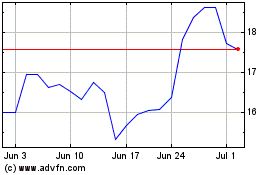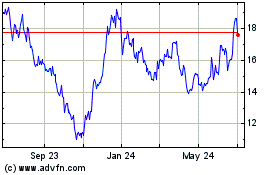By Julie Bykowicz and Ted Mann | Photographs by Octavio Jones for The Wall Street Journal
PORT CANAVERAL, Fla. -- Terminal Three, a cavernous $155 million
structure built for Carnival Cruises, is decked out with the
company's signature blue paint, hundreds of beechwood seats and a
posh VIP room with table lamps so new that sales tags still hang
from some.
It sits empty, near vast, vacant parking lots and fleets of idle
shuttle buses. Sparsely populated hotels and restaurants surround
what was once the world's second-busiest cruising port. Waylaid
port workers scrape by on a mix of low-paying odd jobs and
government help.
"I never thought I would be standing in a food line for hours,"
said James Cox, a 50-year-old porter, who used to earn $27 an hour
wrangling passengers and their luggage. "Just the degradation of
it. You say to yourself, 'Wow, I am really at this point.' "
Like the rest of the maritime tourism industry, Port Canaveral
was mothballed at the start of the coronavirus pandemic. One year
on, as other parts of the economy blink back to life, the U.S.
cruise industry is waiting anxiously for Washington's go-ahead to
sail again -- and worried that a second summer season is about to
be lost.
Other countries including Singapore, Italy and the U.K. have
authorized cruises or set a clear target date for them to set sail.
Almost 400,000 passengers have sailed since some countries first
began allowing cruises in July 2020, according to the industry's
trade group.
But to get started in the U.S., the cruise industry needs
direction from the Centers for Disease Control and Prevention.
The CDC lifted its no-sail order in October and replaced it with
a conditional set of rules; industry officials say the 40 pages of
rules are either indecipherable or impractical, such as a measure
requiring cruise lines to conduct "simulated voyages" with
volunteer passengers.
"I refer to it as the 'impossible-to-sail order' because no
business could operate profitably," Capt. John Murray, Port
Canaveral's chief executive officer, said.
The CDC said guidance is coming soon. "Future orders and
technical instructions will address additional activities to help
cruise lines prepare for and return to passenger operations in a
manner that mitigates Covid-19 risk among passengers, crew
members," spokesman Jason McDonald said in a statement, declining
to comment further.
A White House spokesman didn't respond to a request for
comment.
The order was written before vaccines were approved, and the CDC
hasn't said whether it will revise the guidance to incorporate
vaccinated crew and passengers.
Without CDC direction, cruise lines can't begin the monthslong
process of implementing safety measures and recalling thousands of
workers from around the world, industry officials said.
Washington's hesitancy may in part reflect the cruise industry's
troubles at the beginning of the pandemic.
Cruise lines continued sailing despite known risks from the
coronavirus, an investigation by The Wall Street Journal found.
Ports refused entry to ships with passengers sick with Covid-19,
and giant vessels were stuck at sea.
As the U.S. rollout of Covid-19 vaccines picks up, President
Biden is predicting a return to a sense of normalcy by July. Theme
parks, casinos, airlines and hotels all are operating with
restrictions and safety measures, and the cruise industry says it
can do the same.
"I hate to speculate, but I think CDC looks at it and feels
like, 'Is this a risk we really need to take?' " said Brian
Salerno, senior vice president of global maritime policy at Cruise
Lines International Association, the cruise industry's main trade
group. "To have an industry sidelined like this, based on a bad
perception, is a lot to ask."
Competitors are taking advantage of the vacuum. Hong Kong-based
Genting Cruise Lines said in a March 12 financial filing that
Crystal Serenity would begin sailing from the Bahamas in July,
disembarking in the Americas -- but bypassing U.S. and CDC
jurisdiction. One week later, Royal Caribbean Group said it would
send its own cruise out of Nassau in June, similarly avoiding U.S
ports.
Alaska-bound cruises face an extra hurdle. Most of those ships
are foreign-flagged, so they would have to make a stop in Canada,
because U.S. law forbids such ships from carrying passengers
between U.S. ports. The problem: Canada has banned cruises until
February 2022.
About 60% of all visitors to Alaska arrived by cruise ship in
2019, according to an October Federal Maritime Commission
report.
Alaska's Republican Sens. Dan Sullivan and Lisa Murkowski have
asked the Canadian government to reconsider its ban and introduced
legislation to allow Alaska-bound cruise ships to bypass Canada.
Either plan is predicated on the CDC allowing the resumption of
cruises.
"The CDC -- best scientists in the world. What they are not
designed for is to be a regulator of tourism in America. They're
not good at that," Mr. Sullivan said in an interview. Despite his
office's near-daily outreach to the agency, he said, "they don't
have answers."
The pandemic wiped out, at least temporarily, what was a growth
industry. In 2019, about 14 million cruise-goers departed from the
U.S., generating a record $55.5 billion for the U.S. economy and
supporting more than 436,000 U.S. jobs, according to the cruise
lines association.
The industry's "Big 3" -- global cruise line operators Carnival
Corp., Royal Caribbean and Norwegian Cruise Line Holdings Ltd. --
took major financial hits.
With revenue deeply depressed over the course of 2020, the
companies raised cash with huge bond and stock issues, according to
industry analysts and corporate filings. The big three have told
investors they have enough cash on hand to make it to the 2022
cruising season.
They also have aggressively pared expenses, furloughed workers
and in some cases sold off older, less-efficient ships, which
aren't as profitable to operate.
Even standing still is expensive. Carnival Corp. told investors
in February that it expected to burn through an average of $600
million in cash a month just to keep vessels maintained, sustain
corporate operations and invest in preparations to return to
sea.
"There's been an extraordinary amount of borrowing over the last
year that's happened in the industry," said Melissa Long, a
director at Standard & Poor's who covers the cruise
industry.
The trade group and cruise lines spent $4.4 million on federal
lobbyists last year, the industry's largest such investment since
2008, the start of the last recession, according to lobbying
records.
Carnival Corp. CEO Arnold Donald told investors in January that
the company and its rivals are in "constant communication" with
federal officials, including the CDC, about the reopening
process.
Cruise-related businesses, including ports, say they have been
trying to call Washington's attention to their plight over the past
year, pressing lawmakers and administration officials.
Unions representing port workers on both coasts say workers have
lost hundreds of thousands of hours since the pandemic hit.
In Port Canaveral, Phil Charlton, who has worked in the industry
since 1985, has taken a part-time flower delivery job along with
his wife, Olivia, also a port employee. Bob Baugher, who owns
hotels and transit buses in the area, said his businesses lost $16
million in revenue last year.
Almost 5 million passengers passed through Port Canaveral in
2019, making it second to only Miami for cruising activity. Many
U.S. ports are a mix of cruise and cargo, but here the cruise side
usually makes up about 80% of revenue.
Now, passenger-less vessels pull into the terminal a few times a
month for supplies and maintenance. None of the skeleton crew is
allowed ashore. On a recent March afternoon, the Disney Fantasy
blared a few melancholy strains of "When You Wish Upon a Star" as
it passed by Port Canaveral's Jetty Park.
Mike Horan is monitoring cruise-related Facebook pages for any
sign that his moribund shuttle business might soon be revived.
"That's our port," he wrote on his Facebook page recently,
sharing a photo of a docked ghost ship. "Cruise ships are now just
decorations."
Write to Julie Bykowicz at julie.bykowicz@wsj.com and Ted Mann
at ted.mann@wsj.com
(END) Dow Jones Newswires
March 22, 2021 05:44 ET (09:44 GMT)
Copyright (c) 2021 Dow Jones & Company, Inc.
Carnival (NYSE:CCL)
Historical Stock Chart
From Mar 2024 to Apr 2024

Carnival (NYSE:CCL)
Historical Stock Chart
From Apr 2023 to Apr 2024
